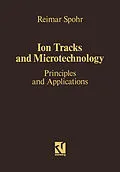I Principles of track creation.- 1 Irradiation technology.- 1.1 Radioactive sources.- 1.1.1 Nuclear reactors.- 1.1.2 Alpha and fission sources.- 1.2 Ion accelerators.- 1.2.1 Characteristic parameters of accelerators.- 1.2.2 Production of highly charged heavy ions.- 1.2.3 Ion deflection and focussing.- 1.2.4 Acceleration techniques.- 1.2.5 Behavior of ions at relativistic energies.- 1.3 Irradiation targets and equipment.- 1.3.1 Wide-beam irradiation devices.- 1.3.2 Scanning ion microbeams.- 1.4 Radiation safety.- 1.4.1 Handling of radioactive sources.- 1.4.2 Basics of sample activation by accelerated ions.- 2 Energy-loss phenomena.- 2.1 Energy-transfer to target electrons.- 2.1.1 Binary-encounter model.- 2.1.2 Impact parameter and scattering angle.- 2.1.3 Transferred kinetic energy.- 2.1.4 Energy-loss per unit length-of-path.- 2.1.5 Cut-off energy.- 2.1.6 Bohr's energy-loss relation.- 2.1.7 Charge-state of projectile-ion.- 2.1.8 Charge-corrected energy-loss relation.- 2.2 Secondary energy-loss effects.- 2.2.1 Energy-loss in multi-elemental targets.- 2.2.2 Energy-straggling and angular straggling.- 2.2.3 Energy-transfer to target nuclei.- 2.2.4 Calculation of ion range.- 3 Formation of the latent track.- 3.1 Track core - atomic defects.- 3.1.1 Coulomb explosion model.- 3.1.2 Atomic collision-cascade.- 3.1.3 Thermal-spike model.- 3.1.4 Resulting primary defects.- 3.1.5 Diffusion and relaxation of defects.- 3.2 Track halo - electronic defects.- 3.2.1 Electron emission from ion trajectory.- 3.2.2 Secondary-electron collision-cascade.- 3.2.3 Translation of deposited energy into effect.- 4 Development of ion tracks.- 4.1 Nucleation of a new phase.- 4.1.1 Origin of phases.- 4.1.2 Basic theory of interface energy.- 4.1.3 Condition for grain growth.- 4.1.4 Formation of condensation nuclei.- 4.2 Track response function.- 4.2.1 Track etch threshold.- 4.2.2 Track sensitization and annealing.- 4.3 Shape of etched tracks.- 4.3.1 Primary factors in track etching.- 4.3.2 Fick's first diffusion law.- 4.3.3 Calculation of track shapes.- 4.3.4 Tracks in crystals.- 5 Observation of ion tracks.- 5.1 Microscopic observations.- 5.1.1 Optical microscope.- 5.1.2 Scanning electron microscope.- 5.1.3 Transmission electron microscope.- 5.2 Diffraction techniques.- 5.2.1 Basic principles.- 5.2.2 Small-angle scattering.- 5.2.3 X ray topography.- 5.3 Auxiliary techniques.- 5.3.1 Electron spin resonance.- 5.3.2 Electrical observations.- 5.3.3 Gas-permeation.- 5.3.4 Mechanical observations.- 6 Resulting structures.- 6.1 Fundamental shapes of etched tracks.- 6.1.1 Single-ion tracks.- 6.1.2 Non-overlapping tracks.- 6.1.3 Overlapping tracks.- 6.1.4 Further possibilities.- 6.2 Stochastic track patterns.- 6.2.1 Two-dimensional track overlap.- 6.2.2 Three-dimensional track overlap.- II Track applications.- 7 Single-ion tracks.- 7.1 Number, size, and deformability of particles.- 7.1.1 Basic relations.- 7.1.2 Resistive pulse technique.- 7.1.3 Deformability and interface energy.- 7.1.4 Red blood cell deformability.- 7.1.5 Suggested pore shapes.- 7.2 Single-pores and super fluidity.- 7.2.1 Basic phenomena.- 7.2.2 Basic relations.- 7.2.3 Flow through a single pore.- 7.2.4 Suggested shapes of weak links.- 8 Multiple ion tracks.- 8.1 Enhanced diffusion.- 8.1.1 Diffusion equations.- 8.1.2 Electric analogue of diffusion equations.- 8.1.3 Solution of dynamic diffusion equation.- 8.1.4 Connected-cavity model.- 8.1.5 Gas permeation through latent tracks.- 8.2 Membrane technology.- 8.2.1 Ion track filters.- 8.2.2 Prospects of track membranes.- 9 Bulk properties.- 9.1 Adjusting magnetic properties.- 9.1.1 Magnetic properties of matter.- 9.1.2 Matrix model of magneto-optic films.- 9.1.3 Experimental results.- 9.1.5 Generation of anisotropy.- 10 Growth areas.- 10.1 Ion lithography.- 10.1.1 Basic techniques in lithography.- 10.1.2 Ion lithographic techniques.- 10.2 Surface texture.- 10.2.1 Light scattering devices.- 10.2.2 Antireflection treatment.- 10.2.3 Further possibilities.- Concluding remarks.- Definitions and units.- List of symbols.
